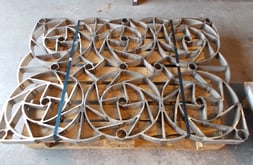Share this
What is the Process of Alloy Fabrication?
by Therser Sales Team on 02-May-2023 11:06:29
Alloy Fabrication
Alloy fabrication is the process of shaping, cutting, and assembling components made from metal alloys. This can include techniques such as casting, welding, machining, and forming. The goal of alloy fabrication is to create a finished product that meets specific design specifications and tolerances. Common products created through alloy fabrication include structural components, machinery and equipment, and aerospace and automotive parts.

There are several steps involved in the process of alloy fabrication:
Design and planning: The first step is to create detailed plans and blueprints for the finished product. This includes determining the materials to be used, the specific alloy, and the overall dimensions and shape of the product.
Material preparation: The materials, usually in the form of metal alloy sheets or rods, are then prepared for fabrication. This may involve cutting the materials to the correct size and shape.
Forming: The materials are then formed into the desired shape using techniques such as stamping, casting, or rolling.
Machining: The formed parts are then machined to their final shape using techniques such as drilling, turning, milling, or grinding.
Assembly: The parts are then assembled together using techniques such as welding, riveting, or bolting.
Finishing: The final product is then finished to the desired surface finish. This can include cleaning, polishing, painting or other surface treatment.
Inspection: Quality inspection is performed on final product, checking if the product has the right dimension and mechanical properties.
Note that this is a general description and specific process may vary depending on the alloy and the product being fabricated.
There are many different types of metal alloys that can be used in alloy fabrication, depending on the specific properties and characteristics required for the finished product. Some common metals and alloys used in alloy fabrication include:
Aluminum: Lightweight, corrosion-resistant, and good for high-temperature applications.
Steel: Strong, durable, and widely used in construction and machinery.
Copper: Good electrical and thermal conductivity, corrosion-resistant, and used in electrical components and piping.
Titanium: Strong, corrosion-resistant, and biocompatible, used in aerospace and medical applications.
Nickel: Good corrosion resistance and strength at high temperatures, used in power generation and chemical processing.
Magnesium: Lightweight, good for high-temperature applications and shock absorption.
Zinc: Good corrosion resistance, used in galvanizing and electroplating.
Gold: Good electrical conductivity, used in electronics and jewelry.
Silver: Good electrical conductivity and reflectivity, used in electronics and mirrors
-Tungsten : High density, high melting point, and good resistance to wear and tear.
This is by no means an exhaustive list, as new alloys are being developed all the time, with different properties and suitability for different applications.
Please contact our sales team today on 44 (0)1782 824453 or drop us an email to sales@therseruk.com
Share this
- Company News (90)
- Battery Materials (41)
- kiln (37)
- fabrication (29)
- Alloy (27)
- Furnace (27)
- Welding (16)
- Industrial Kilns (15)
- Battery (13)
- Ceramic Kilns (13)
- Processes (13)
- alloy fabrication (13)
- Shuttle Kilns (12)
- RTO’s (11)
- Vacancies (11)
- Hydrogen (10)
- Therser UK (9)
- Tunnel Kiln (9)
- Refractory (8)
- Therser (8)
- Wellman Furnaces (8)
- Brickwork (7)
- Case Studies (7)
- Afterburners (6)
- Fibre Lining (6)
- electric (6)
- Almor Wellman (5)
- thermal engineers (5)
- Biochar (4)
- Exhibition (4)
- Pyrolysis (4)
- Servicing (4)
- Spares (4)
- heat treatment (4)
- History (3)
- Ceramics Uk (2)
- Combustion Control Upgrades (2)
- Nitrogen (2)
- Temperature Control Rings (2)
- gas (2)
- Certificates (1)
- Instrumentation (1)
- MMC (1)
- RHK (1)
- Roller Hearth Kiln (1)
- Test Trials (1)
- aerospace (1)
- analyser (1)
- elec (1)
- oxygen (1)
- vans (1)
- September 2025 (2)
- May 2025 (2)
- March 2025 (1)
- February 2025 (2)
- January 2025 (5)
- December 2024 (5)
- November 2024 (7)
- October 2024 (5)
- September 2024 (4)
- August 2024 (14)
- July 2024 (13)
- June 2024 (2)
- May 2024 (5)
- April 2024 (13)
- March 2024 (8)
- February 2024 (12)
- January 2024 (14)
- December 2023 (6)
- November 2023 (12)
- October 2023 (24)
- September 2023 (11)
- August 2023 (11)
- July 2023 (9)
- June 2023 (15)
- May 2023 (53)
- April 2023 (5)
- March 2023 (6)
- February 2023 (7)
- January 2023 (3)
- December 2022 (8)
- November 2022 (5)
- October 2022 (11)
- September 2022 (1)
- August 2022 (2)
- July 2022 (1)
- June 2022 (2)
- May 2022 (1)
- March 2022 (1)
- February 2022 (1)
- January 2022 (1)
- December 2021 (3)
- October 2021 (1)
- August 2021 (1)
- June 2021 (1)
- May 2021 (4)
- April 2021 (2)
- March 2021 (4)
- February 2021 (2)
- December 2020 (3)
- November 2020 (1)
- September 2020 (3)
- May 2020 (1)
- April 2020 (2)
- March 2020 (1)
- January 2020 (1)
- December 2019 (1)
- July 2019 (2)
- June 2019 (1)
- April 2019 (2)
- March 2019 (3)
- February 2019 (4)
- December 2018 (1)
- November 2018 (1)
- September 2018 (2)
- August 2018 (1)
- July 2018 (1)
- May 2018 (3)
- April 2018 (1)
- February 2018 (3)
- January 2018 (2)
- December 2017 (3)
- November 2017 (1)
- October 2017 (2)
- September 2017 (4)
- August 2017 (1)
- July 2017 (2)
- June 2017 (2)
- May 2017 (3)
- April 2017 (3)

